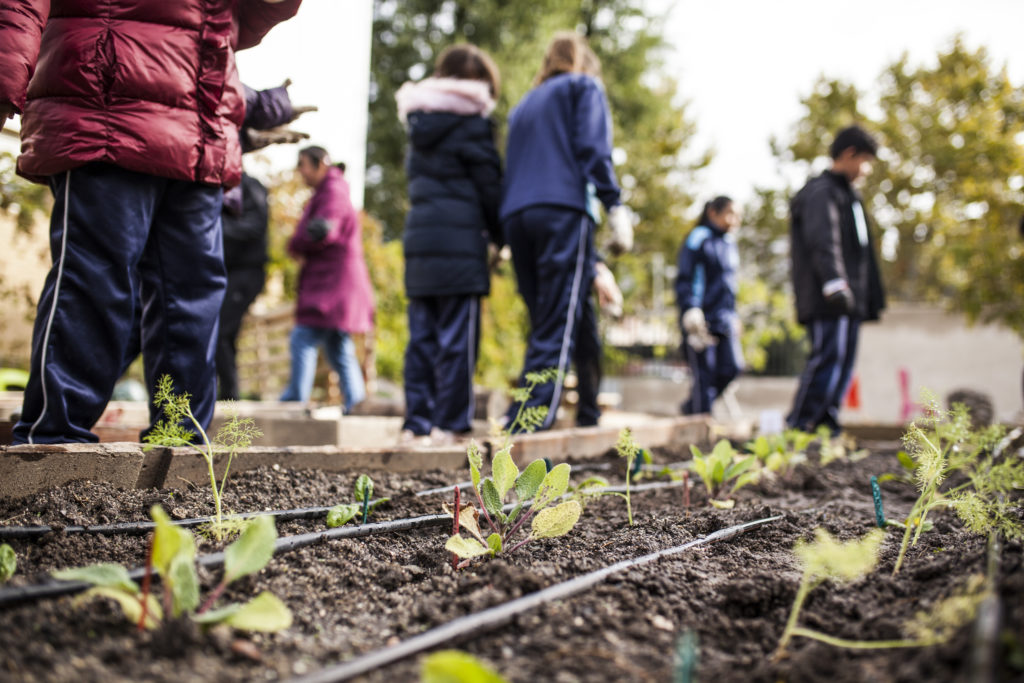Nurture Healthy Nutrition Habits
- »
- Prevention
- »
- Early Childhood Education
- »
- Nurture Healthy Nutrition Habits
Teach Healthy Eating and Drinking Habits to Young Children
By nurturing healthy nutrition habits in young children, you can give them a healthier future. Food preferences start to develop in infancy, so children will learn lifelong eating habits based on the kinds of foods served to them when they are young. Early learning centers should offer children healthy food choices that will nurture their bodies and fuel brain development.
Farm to Early Care and Education

Farm to early care and education works to build children’s acceptance and preference for healthy foods by increasing access through local food purchasing and gardening. In addition, farm to early care and education aims to advance racial and social equity by increasing access to healthy, local foods and high quality education opportunities for all children.
As part of farm to early care and education, schools are encouraged to implement gardens. School gardens are outdoor classrooms where students learn core standards through hands-on experiential learning. Lessons in school gardens can teach students about science, math, social studies and language arts.
Ways to implement a farm to early care and education could include:
- Weekly menus that include local, fresh food
- Staff professional development on gardening, food, nutrition and agriculture education
- Ongoing communication with families about local foods included in meals and snacks
- Gardening opportunities that teach children how to plant, maintain, observe, harvest, wash and taste fresh produce
Child and Adult Care Food Program
The Child and Adult Care Food Program (CACFP) is a federal program that provides reimbursements for nutritious meals and snacks to eligible children and adults who are enrolled for care at participating child care centers, day care homes and adult day care centers. The United States Department of Agriculture (USDA) provides guidance, resources, best practices and training for CACFP centers and day care homes to support them in providing healthy, balanced meals and snacks to the children and adults they serve.
Healthy Drinking Habits
It is important for children learn to develop a preference for healthy drinks to quench their thirst. Hydrating the body is important so that children can happily play, explore and learn throughout the day.
As an adult, modeling healthy drinking by avoiding sugary drinks in front of children will help teach them healthy drinking habits. When serving children drinks, limit juice to no more than four to six ounces of 100% fruit juice daily and never serve sugary drinks such as fruit drinks, sports drinks, sweet tea and soda. You can also try diluting 100% fruit juice with water to train children’s palates to enjoy mild sweetness.
Choose Water First
Making water the first choice when grabbing a drink is an important habit for kids to learn. Water is best for quenching thirst because it keeps active kids hydrated and helps children maintain a healthy weight. It’s also good for oral health—especially when fluoridated—because it reduces acid in the mouth that can cause cavities.
Tips to Make Drinking Water Easy and Fun

It’s important to make sure kids have access to the things they need to make choosing water the easy choice! Start by having small cups and child-size water pitches available so they can serve themselves if they are old enough. Also, by avoiding serving toddlers water in sippy cups or baby bottles, you can make drinking water more appealing. You should also teach children how to use water fountains and how to refill water bottles.
Other ways to make drinking water easy and fun for kids include
- Add fruit slices or berries to water for extra taste.
- Read books and plan activities about water.
- Select a child to be the “water helper” for the day.
- Invest in a small portable water cooler for outside use.
Drink Milk with Meals
Milk is also a good beverage choice for young children because it allows them to get bone-building calcium, Vitamin D and other important nutrients that their growing bodies and minds need. With meals, it is best to serve milk, but water should be made available too.
Depending on your child’s age, consider what type of milk you are serving.
- Infants (up to 12 months old) should only get breastmilk or formula—never cow’s milk.
- One- to two-year-olds should be served whole milk. Toddlers need the extra dietary fats to help their brain and bodies develop and grow.
- Children two years and older should only be served 1% or non-fat milk unless directed otherwise by the child’s health care provider.
Family-Style Dining
How food is served to children can impact their eating habits. Family-style dining is the best practice when eating with children, including in child care settings. This type of dining is when adults and children are at a shared table and food is available for everyone to serve themselves when possible. By having adults model behaviors, children learn important skills such as appropriate serving sizes and listening to hunger and fullness cues and are more likely to try new foods and make healthy choices.
Other benefits of family-style dining include:
- Physical Development: Fine motor skills are developed as children use utensils to serve and eat as well as child-sized pitchers to pour. Eye-hand coordination benefits from these simple tasks as they learn to control the small muscles in the hands.
- Language Development: Language and literacy skills are developed as children engage in conversation with staff and other children. Teachers can use this time to talk to children about activities an important events in their lives. Children have the opportunity to talk about the food being served, describe the taste, how the food looks and feels, and classifying and comparing the food to other foods that they have tried.
- Cognitive Development: Children’s problem-solving, reasoning, decision-making and understanding are developed by learning amounts, sizes, textures, numbers, counting, positions of food items and tableware.
How Can I Implement Family-Style Dining at My Child Care Center?
Being prepared in meal preparation and organization is important for successfully implementing family-style dining at your child care center. Based on children’s development and age, food should be sized appropriately to prevent choking hazards. Food should be served in small plastic bowls that can be easily held and passed by children. Serving spoons should be child-sized and reflect the proper portion size for the type of food being served. Consider using a cart for storing the food, tableware and tubs to roll into classrooms. Having food and needed materials on a cart prevents staff from having to get up and down during mealtime.
Positive Eating Environment Self-Assessment
Are there ways you can improve your center’s mealtime practices? Take the positive eating environment self-assessment for early care and education programs to access basic mealtime practices at your facility. This brief, user-friendly assessment can help center-based and family child care programs that serve 3 -5 year olds. Use this tool to evaluate the availability of healthy nutrition and mealtime environments and facilitate staff discussions and policy planning.